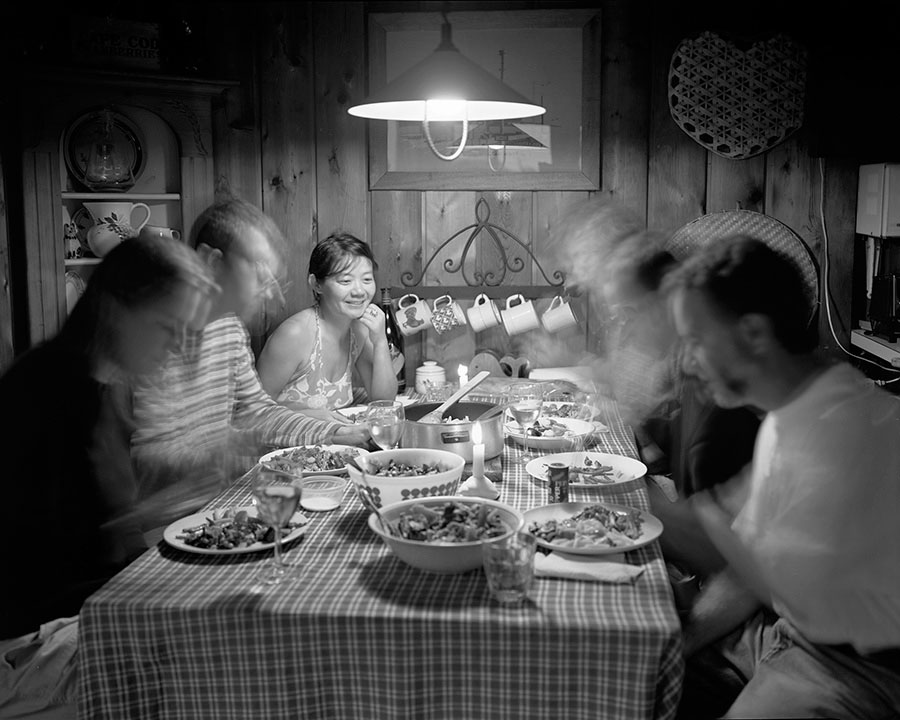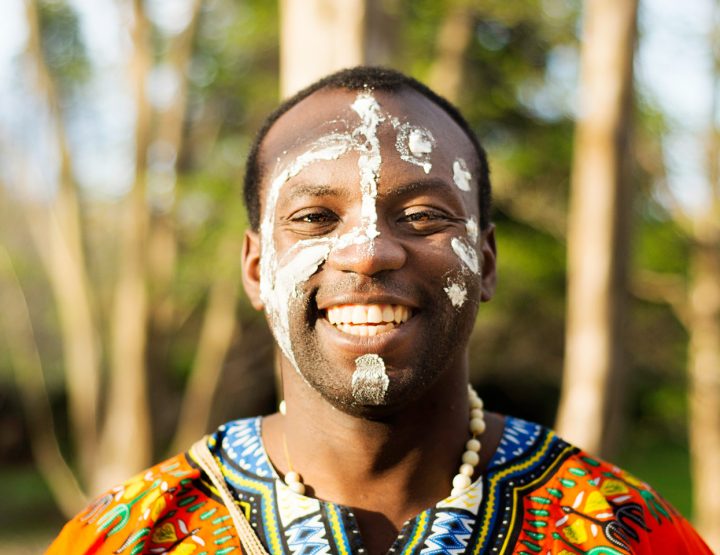With Dad: Gene’s birthday, August 5, 2006 (Dirado’s mother Rose and sister Gina serving cake.)
I first met Stephen DiRado in 2012, after I saw his newly completed documentary film, Summer Spent, at the Harbor View Hotel. The second time I met him was in August 2014, on the day he picked me up to accompany him on his daily late-afternoon photo shoot on the beach in Aquinnah. For the last 27 years, Stephen, a professor of photography at Clark University has been documenting his living experiences on Martha’s Vineyard using an old box film camera.
Stephen’s work is a ritual: Every day while he is on-Island, he heads up to Moshup Beach, arriving just after 4 pm. He arranges his knapsack, containing his large-format camera, and hauls in reflector boards and a tripod. He does not know who he will see on the beach — people he knows, or people he will meet — who will spark his interest.
Making portraits, he says, is his way of getting to know people; nudes reflect for him a complete portrait. He is typically working on several simultaneous projects — the beach series, a series at a dinner table surrounded by friends who meet annually on the Vineyard each June, portraits of his father aging (and, Stephen says, his having to let go when his father died), and the “Jumper Series” done of swimmers in Edgartown, which, he said, he found to be like the experience with his father: his need to watch people let go in that instant they took a leap from the edge of the railing
The following edited excerpts below are from our conversation:
Valerie Sonnenthal: When did you start taking pictures?
Stephen DiRado: At a very young age. My father was an artist working for the state of Massachusetts. If you grew up anywhere in Massachusetts in the 1960s, ’70s, or ’80s, and opened up a paper like the Boston Globe, and there was an artist illustration of a new DPW [Department of Public Works] building or the new state commissioner,, anything to do with the state, those were all done by my father…. I always watched my father paint, draw, or photograph. He taught me at a very young age how to draw. He wanted me to be an architect or a painter, because there was money in it…. He taught me to draw realistically. I was even making drawings for five bucks apiece, portraits of friends, family, neighbors, but I always kept looking at the camera.
VS: The forbidden fruit.
SD: Yeah, finally I picked it up at 12 years old; a Rolleiflex, you know, one of those twin-lens reflex cameras that you hold and look down into.
VS: A view camera, a 2¼?
SD: Yeah, a 2¼, and I went out and immediately photographed things I was drawing, and that was friends and family and neighbors. … So my father was very disappointed in that [laughs].
VS: There goes the architect.
SD: Oh man, this is the bottom of the food chain, photography; you don’t want to go there. Don’t forget, this is the late ’60s and ’70s. You know he was right — they were the cheapest for-hire business; it was a real struggle to be a photographer back then, but I was just so in love with the camera. I even worked, when I was in high school, for the local paper. I lied about my age — I was actually 15. I told them I was 18. Didn’t have a car. I had a bicycle. Didn’t tell them that. I would go off on my bicycle to shoot the assignments on the weekends while the other photographers were out fishing. I was in my element. It was something I knew I was going to do the rest of my life.

With Dad: Marlborough, Gene’s Birthday, August 5, 2006 (My mother Rose and sister Gina serving cake.)
VS: OK, so you’re now shooting for the local paper and going everywhere on your bicycle, and then next?
SD: Next is that I was offered a full-time job to work for the paper when I graduated from high school. And my father said, “I will break your legs if you do it. I want you to go to college and get a degree, and then if you want to come back and work for the paper that’s fine, but you need to have some latitude here. You need to have that insurance you can move on to other jobs.” Of course he was absolutely right. What happened was I went on to two different schools, the School of the Worcester Art Museum, a three-year certificate that would get you a cup of coffee. From there I went on to the Massachusetts College of Art and Design to get a B.F.A. … I double-majored in painting and photography, but photography was clearly where I was at.… And then I realized I could make the medium more about me [laughs]. I can make it my art, and not use it a service for others, but really explore my own emotions, intellect, and possibilities. The thing is, no — I did not go back to journalism, but I’m kind of a hybrid between journalism and art that is basically self-indulgent, about me. I combine the two worlds of self-exploration, as well as reaching out to others to work in a narrative form which is a lot like painting. So I brought in some painterly elements when it comes to a narrative.
VS: When you started your own work, what were you photographing?
SD: Interestingly enough, even in high school, I started photographing … family and friends. The vernacular, things that are common around me. So even in high school I won an award for photographing a dinner party — I think it was a Thanksgiving at my parents’ house with the Rolleiflex — who’s at the table, what is the table setting all about, lighting the situation, directing each person. I was already formed, as far as my style goes, at a terribly young age.
VS: So you’re using your family, normal family gatherings, holidays and events. Besides the lighting you are adding, you are not setting up the situation, right?
SD: I’m 100 percent Italian, and I really do come from that family of mangia, eat, be happy. If you don’t have a full belly, then something must be wrong. So even growing up — and this does feed back into my work — my mother always had an extra place setting, just in case somebody walked in for dinner. I grew up with the whole openness that everybody should share food at the table; nobody should be left out. If a friend is coming to visit, have them come over early enough to have dinner.
VS: Shooting on Moshup Beach has held your interest over how many years?
SD: Here on the Island 28 years, and I don’t know how to end it.
VS: You don’t know how to end it, or you don’t want to end it?
SD: I always want to end everything [laughs], so I can move onto new things. But the problem with Martha’s Vineyard is that as I grow older, the Island changes in front of my eyes, and the goddamn place is intoxicatingly beautiful for me in the sense that I just can’t. It’s my mistress. I want to leave it, but it keeps beckoning me back. And as I change spiritually — you know if I spend 20 years documenting my father with Alzheimer’s, and with each year visiting him in a nursing home, two days, three days a week, with the same equipment I use down here — then I come here and see things completely different.
VS: Some artists say their home is their wife and their country home is their lover …
SD: My wife Donna and I met coming out of college. I was 19, she was 24 with a child, divorced. And I said to her, You’re so perfect, you’re so lovely, I love you deeply, I want to be with you for as long as it takes, ’cause nothing is perfect and I can’t guarantee we’ll be together for life, but let’s try to make this work, but we have a problem. And the problem is that my mistress is my art, and that’s how I survive. And that will take me away for days, months, and maybe even years, and if you can tolerate that mistress, the art, then we have a relationship. And she said yes, and to this day it has worked.
VS: What does your wife do while you’re doing all this stuff?
SD: She lives in Worcester most of the time, and I come down here to work.… It’s a unique life that I live. And not any woman would put up with this.
VS: Tell me about how you came to the Island the first time, and your first time in Aquinnah.
SD: My father was a beach bum. So growing up — 4, 5, 6 years old — he’d wake us up at 6 am and say, “Hey kids, everybody in the car,” and ask my mother to pack a large cooler with sandwiches, soft drinks, and beers, bring the umbrella, and we’d end up at any beach from Maine to down here at Martha’s Vineyard. Back in the ’60s, people don’t realize this, you could just drive down on the highway to Woods Hole and ask when is the next ferry leaving, and they’d say right there right now, give us $24, and you’d hop on and nobody cared.
VS: So was today a good day for you?
SD: Yeah, I shot four photos. I carry eight to 10 plates, but I very rarely shoot 10…. Today I brought four plates and I shot four. It’s a yin and yang situation down there. The portraits really came about when my father was dying and leaving this earth. It was the last two years of his life, when I found a new way to communicate with him at the nursing home was to physically hold him, and my camera came in extremely close for these photos, as well as part of my emotional connections. So when I came to the beach very depressed and always thinking about my father, I started to ask my subjects if I could hold them and hug them. That’s when I decided the camera needed to do that; as an artist it needed to express, it needed to be a window into what I am processing. Hopefully my photos are half of what I saw in my head, my previsualization.
VS: You don’t know when you’re going to end this project?
SD: I thought that if the casino happened it would end it [laughs]. You know what would happen to the beach? I would have done the project one more year, to show how it changed. Now I have an ending. A very sad ending, but what’s happening is this particular project.






Leave a reply